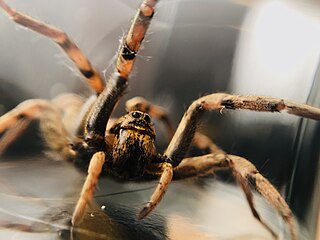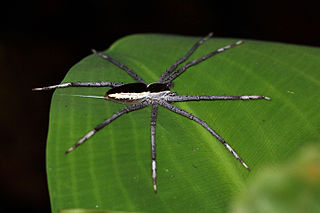
Wolf spiders are members of the family Lycosidae. They are robust and agile hunters with excellent eyesight. They live mostly in solitude, hunt alone, and usually do not spin webs. Some are opportunistic hunters, pouncing upon prey as they find it or chasing it over short distances; others wait for passing prey in or near the mouth of a burrow.

Nursery web spiders (Pisauridae) is a family of araneomorph spiders first described by Eugène Simon in 1890. They resemble wolf spiders (Lycosidae) except for several key differences. Wolf spiders have two very prominent eyes in addition to the other six, while a nursery web spider's eyes are all about the same size. Additionally, female nursery web spiders carry their egg sacs with their jaws and pedipalps instead of attaching them to their spinnerets as wolf spiders do. When the eggs are about to hatch, a female spider builds a nursery "tent", places her egg sac inside, and stands guard outside, hence the family's common name. Like the wolf spiders, however, the nursery web spiders are roaming hunters that don't use webs for catching prey.

The Artoriinae are a subfamily of wolf spiders. The monophyly of the subfamily has been confirmed in a molecular phylogenetic study, although the relationships among the subfamilies was shown to be less certain.
Ocyale is a wolf spider genus in the family Lycosidae.

Trochosa is a large wolf spider genus found worldwide.

Allotrochosina is a genus of spiders in the family Lycosidae. It was first described in 1960 by Roewer. As of 2017, it contains 3 species.
Arctosomma is a monotypic genus of spiders in the family Lycosidae. It was first described by Carl Friedrich Roewer in 1960. As of 2023, it contains only one species, Arctosomma trochosiforme, found in Ethiopia.
Auloniella is a genus of spiders in the family Lycosidae. It was first described in 1960 by Roewer. As of 2017, it contains only one species, Auloniella maculisterna, found in Tanzania.
Dolocosa is a genus of spiders in the family Lycosidae. It was first described in 1960 by Roewer. As of 2017, it contains only one species, Dolocosa dolosa, on the island of Saint Helena.
Edenticosa is a genus of spiders in the family Lycosidae. It was first described in 1960 by Roewer. As of 2017, it contains only one species, Edenticosa edentula, on the island of Bioko.

Geolycosa is a genus of wolf spiders first described in 1904.

Hoggicosa is a genus of wolf spiders first described by Carl Friedrich Roewer in 1960. The name is a reference to arachnologist Henry Roughton Hogg.
Hognoides is a genus of spiders in the family Lycosidae. It was first described in 1960 by Roewer. As of 2017, it contains 2 species.
Megarctosa is a genus of spiders in the family Lycosidae. It was first described in 1948 by Caporiacco. As of 2017, it contains 7 species.
Molitorosa is a genus of spiders in the family Lycosidae. It was first described in 1960 by Roewer. As of 2017, it contains only one Brazilian species, Molitorosa molitor.
Mustelicosa is a genus of spiders in the family Lycosidae. It was first described in 1960 by Roewer. As of 2017, it contains 2 species.
Paratrochosina is a genus of spiders in the family Lycosidae. It was first described in 1960 by Roewer. As of 2017, it contains 3 species.
Pavocosa is a genus of spiders in the family Lycosidae. It was first described in 1960 by Roewer. As of 2017, it contains 5 species.

Tetralycosa is a genus of Australian spiders in the family Lycosidae first described by Roewer in 1960, later revised by Framenau & Hudson to include thirteen species. Genetic studies show that these spiders all diverged from a common ancestor who likely wandered into the salty area and remained. They live exclusively in certain saline environments of Australia's interior, including coastal beaches, mound springs, clay pans, and salt lakes. There haven't been enough studies to establish a conservation status, but some species have only been found in solitary salt lakes, suggesting that the increase of mining, agriculture, recreational, and similar disturbances of these unique ecosystems may eventually lead to their extinction if not properly regulated.

Venatrix is a genus of wolf spiders first described by Carl Friedrich Roewer in 1960.








